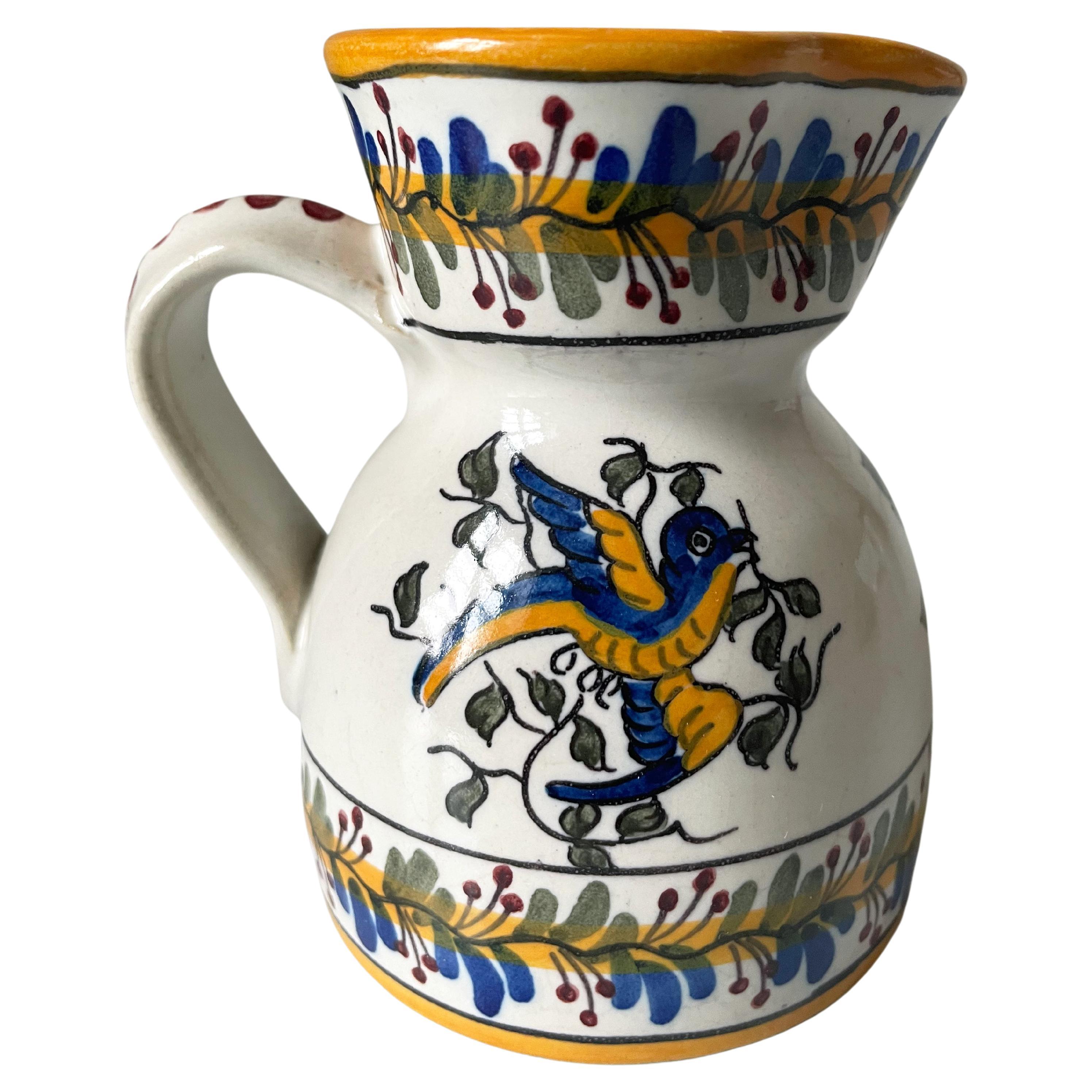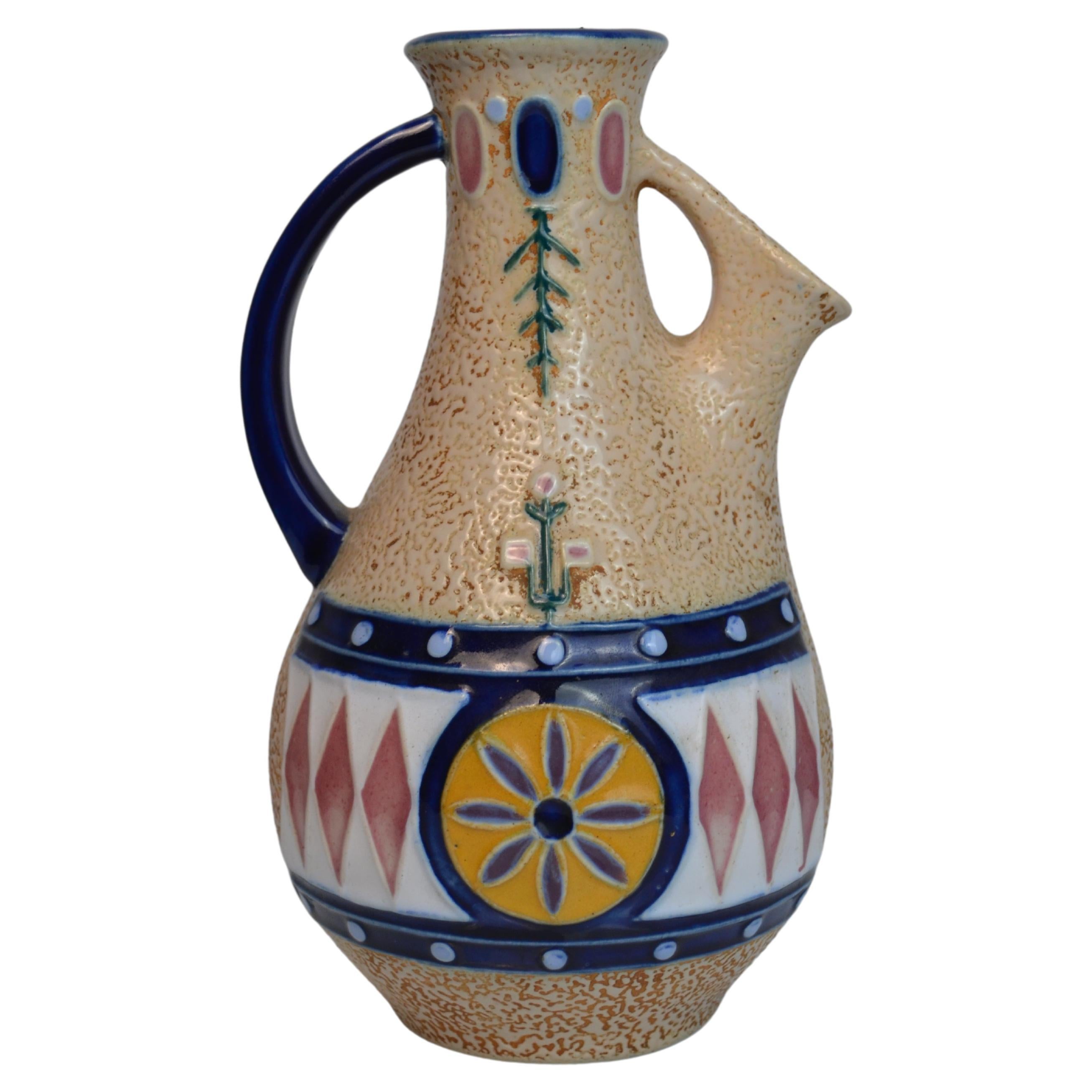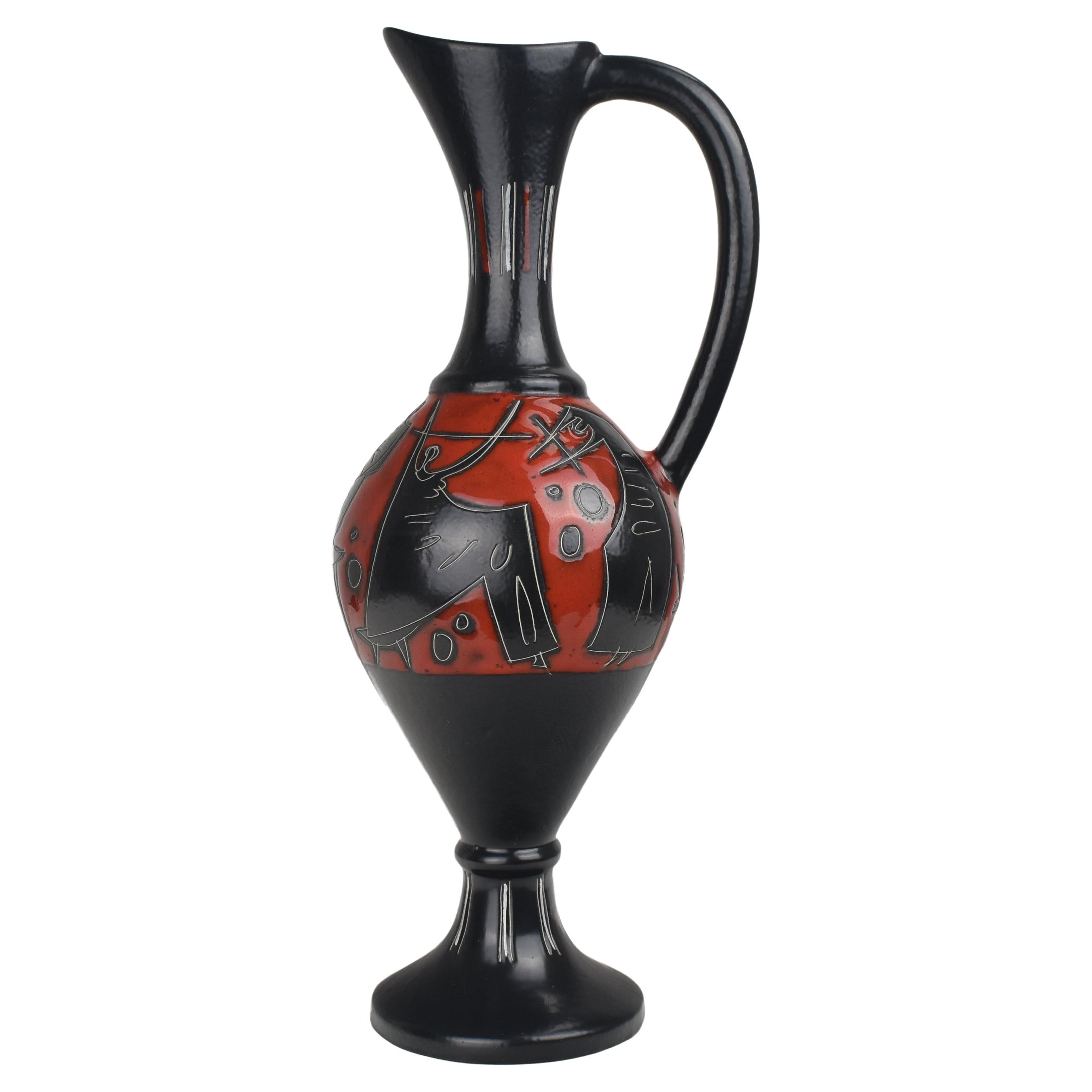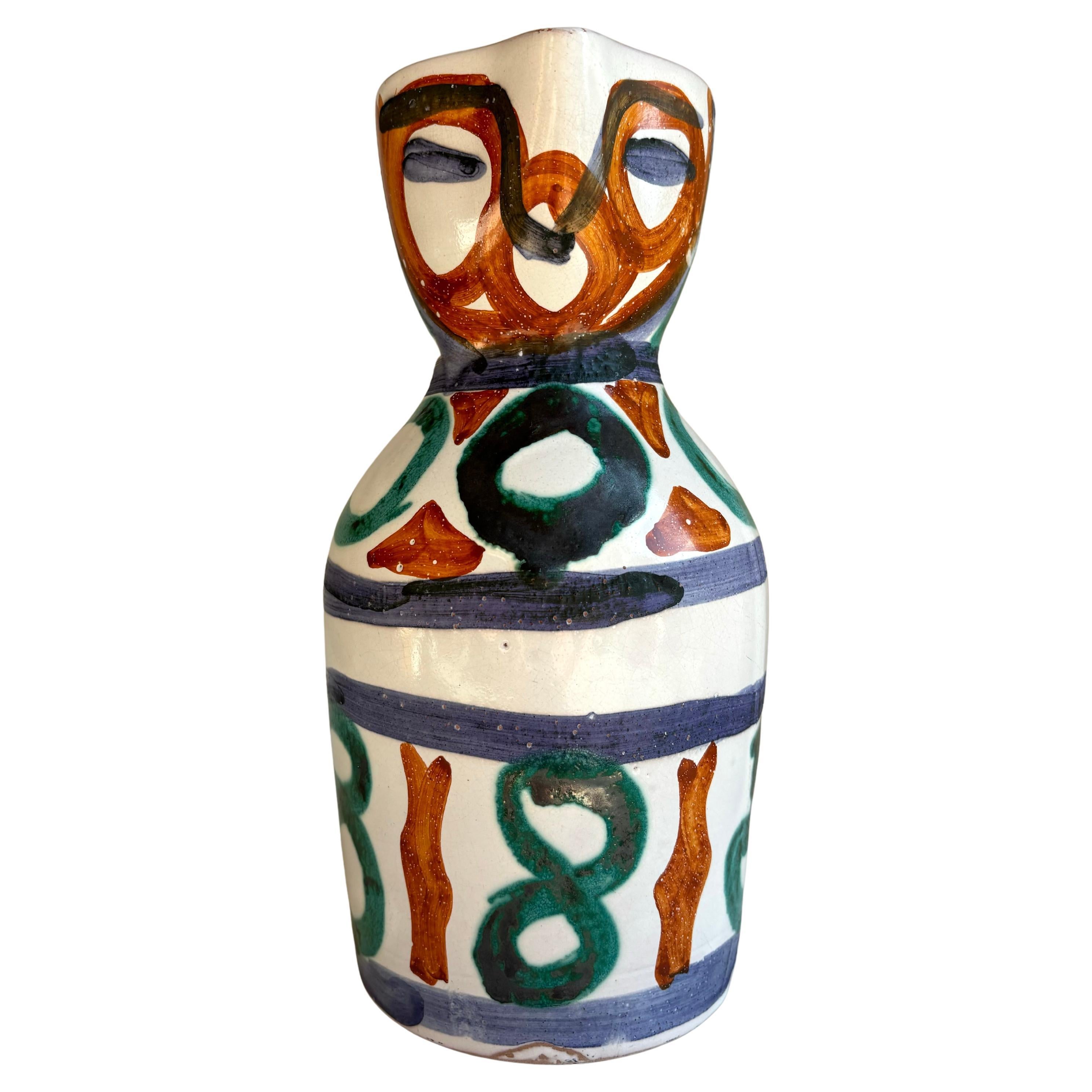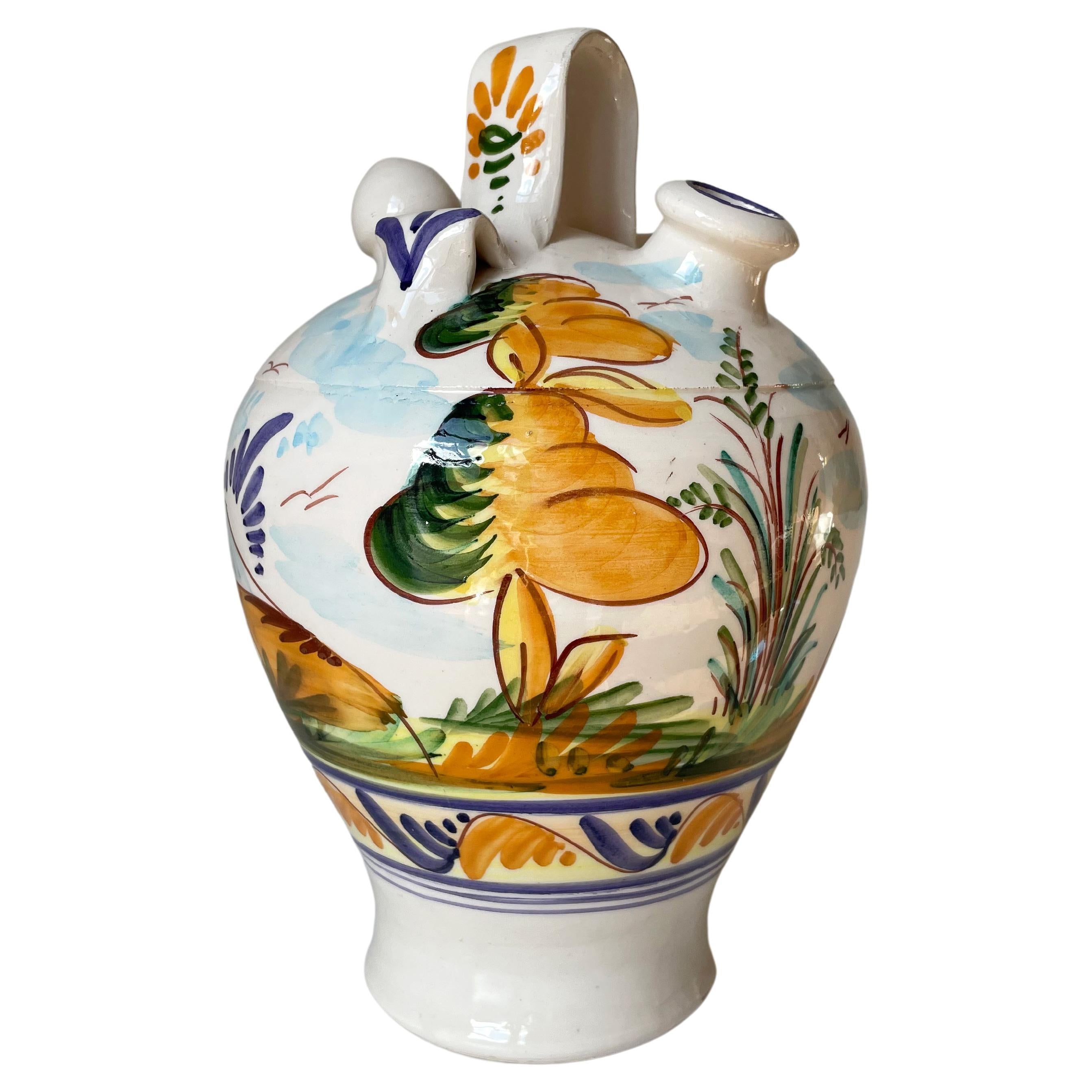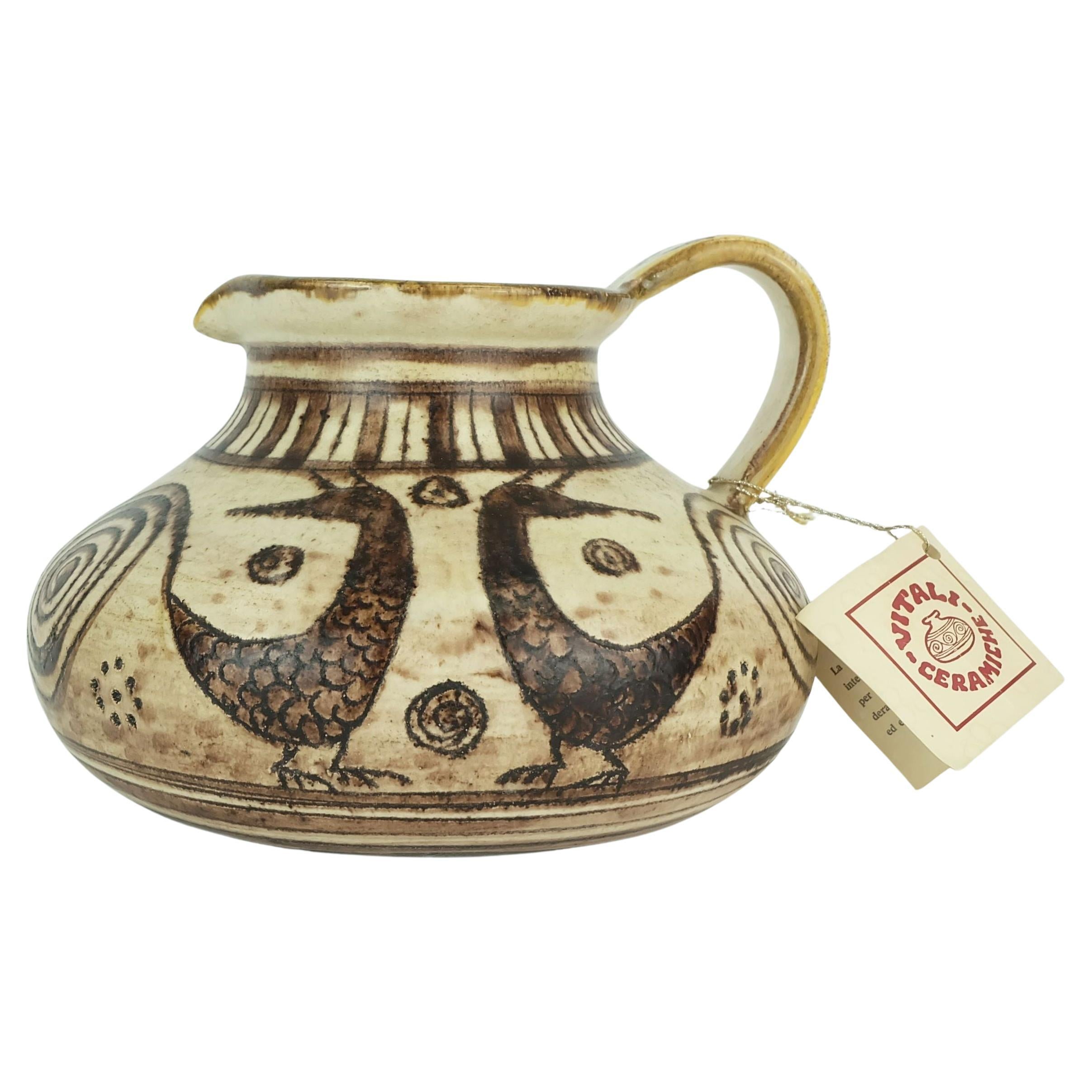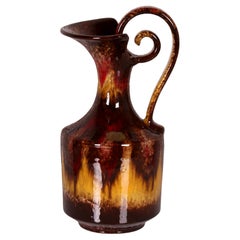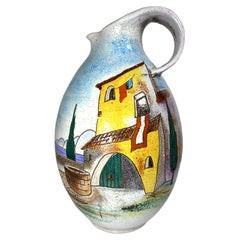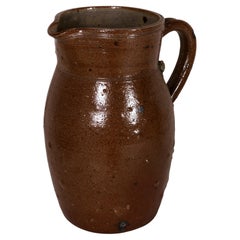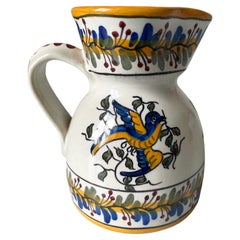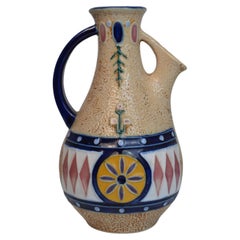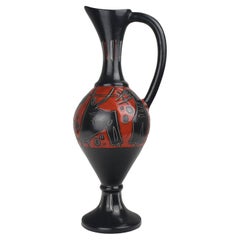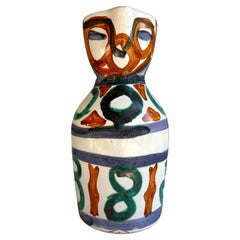Items Similar to one of a kind Ceramica PONZA Italy Wine Pitcher Jug Vallauris Picasso Style 60s
Want more images or videos?
Request additional images or videos from the seller
1 of 13
one of a kind Ceramica PONZA Italy Wine Pitcher Jug Vallauris Picasso Style 60s
$381.73
£282.22
€320
CA$525.07
A$583.64
CHF 305.93
MX$7,127.70
NOK 3,819.40
SEK 3,593.35
DKK 2,436.15
About the Item
one of a kind...
Ceramica PONZA Italy
Wine Pitcher
Jug Vallauris Picasso Style 1950s / 1960s
Ø 16cm ~ Ø max 24cm ~ weight: 1178grs
Ponza is one of the Pontine Islands in the Tyrrhenian Sea, about 50 kilometres southwest of Terracina. It belongs to the Italian region of Lazio and is part of the municipality of Ponza in the province of Latina.
The island is crescent-shaped and stretches for seven kilometres from the south to the north-east. The island is between 200 and 2300 metres wide and has a surface area of 7.3 square kilometres. The island has a population of around 3,300, most of whom live in the main town of Ponza on the south-east side of the island and in Le Forna on the west side.
The landscape of the island is hilly, with Monte Guardia in the southern part reaching an altitude of 279 metres. Geologically, Ponza is of volcanic origin. The coast is mostly rocky. However, there are beaches, some of which can only be reached by sea. The most famous beach is Chiaia di Luna, which can be reached through a 168 metre long Roman tunnel. Chiaia di Luna is surrounded by a wall of tufa rock 80 to 100 metres high. The beach was reopened on 14 August 2010 after two years of safety work following rock falls that caused fatalities, but was closed for an uncertain period shortly afterwards following further rock falls. It is not yet clear when the beach will reopen to visitors[1].
Ponza is a popular holiday destination, especially for Italian tourists, especially those from Rome. The island can be reached by ferry several times a day from Terracina, Formia, Anzio and San Felice Circeo.
Off the north-eastern tip of Ponza lies the uninhabited island of Gavi. The highest point of the 14-hectare island is 101 metres above sea level.
In ancient times the island was called Pontia. The exiled Pope Silverius is said to have died and been buried on Ponza (or Palmarola) in 537. The monastery of Santa Maria di Ponza developed from hermitages on the island and joined the Cistercian Order in 1245, but was moved to Formia near Gaeta in the 15th century.
- Dimensions:Height: 8.27 in (21 cm)Width: 6.3 in (16 cm)Depth: 9.45 in (24 cm)
- Style:Mid-Century Modern (Of the Period)
- Materials and Techniques:
- Place of Origin:
- Period:
- Date of Manufacture:1955 - 1965
- Condition:
- Seller Location:Landshut, DE
- Reference Number:1stDibs: LU8587241860612
About the Seller
5.0
Vetted Professional Seller
Every seller passes strict standards for authenticity and reliability
1stDibs seller since 2023
21 sales on 1stDibs
- ShippingRetrieving quote...Shipping from: Bodenkirchen , Germany
- Return Policy
Authenticity Guarantee
In the unlikely event there’s an issue with an item’s authenticity, contact us within 1 year for a full refund. DetailsMoney-Back Guarantee
If your item is not as described, is damaged in transit, or does not arrive, contact us within 7 days for a full refund. Details24-Hour Cancellation
You have a 24-hour grace period in which to reconsider your purchase, with no questions asked.Vetted Professional Sellers
Our world-class sellers must adhere to strict standards for service and quality, maintaining the integrity of our listings.Price-Match Guarantee
If you find that a seller listed the same item for a lower price elsewhere, we’ll match it.Trusted Global Delivery
Our best-in-class carrier network provides specialized shipping options worldwide, including custom delivery.More From This Seller
View Alla quite unique art pottery vase Italy 1970s (appears to be composed of glass ! )
Located in Landshut, BY
This is an exceptional example of Italian design and craftsmanship.
The jug-style vase with a handle initially appears to be composed of glass. Upon closer examination, it becomes ...
Category
Vintage 1970s Italian Mid-Century Modern Vases
Materials
Pottery
1950s Studio Keramik floor Vase series GARDA Atelier Huber Roethe Landshut
Located in Landshut, BY
STUDIO KERAMIK FLOOR VASE
Atelier Herta Huber Roethe Landshut 1950s
marked "HR"
Manufacturer ATELIER HUBER ROETHE
Design Period 1950 to 1959
Production Period 1950 to 1959
Count...
Category
Vintage 1950s German Mid-Century Modern Vases
Materials
Pottery
huge hand made archaic JUG Gritstone Portugal 1970s JAR Pitcher
Located in Landshut, BY
huge hand made archaic JUG Gritstone Portugal 1970s
Category
Vintage 1970s Portuguese Art Deco Ceramics
Materials
Stoneware
SET of 2 traditional Italian Jugs GUBBIO floral handpainted Jug Wine Pitcher
By C.A.M. Gubbio
Located in Landshut, BY
Design Period 1955 to 1965
Production Period around 1960
Country of Manufacture Italy Gubbio Umbria (Provincia di Perugia)
MARKED: by artist C.A.F.F. Gubbio
:-:very good condi...
Category
Mid-20th Century Italian Rustic Jars
Materials
Maiolica
Art Nouveau Southern French Fayance art pottery FLOOR VASE rare colours&pattern
Located in Landshut, BY
A giving joy beautiful French Fayence Floor Vase
fantastic Art Nouveau pattern - Impressing Colours
Manufacturer unknown - marked
Design Period 1915 - 1925
Country of Manufacture : France
H / height: 46 cm ~ Gew. / weight: 4550 grs
DM / diameter max: 28 cm ~ DM oben / diameter inner rim: 19.8 cm
.... an ode to Southern France
A Legend of Provence
by Adelaide Anne Procter (30 October 1825 – 2 February 1864)
The lights extinguished, by the hearth I leant,
Half weary with a listless discontent.
The flickering giant-shadows, gathering near,
Closed round me with a dim and silent fear.
All dull, all dark; save when the leaping flame,
Glancing, lit up a Picture's ancient frame.
Above the hearth it hung. Perhaps the night,
My foolish tremors, or the gleaming light,
Lent power to that Portrait dark and quaint, —
A Portrait such as Rembrandt loved to paint, —
The likeness of a Nun. I seemed to trace
A world of sorrow in the patient face,
In the thin hands folded across her breast: —
Its own and the room's shadow hid the rest.
I gazed and dreamed, and the dull embers stirred,
Till an old legend that I once had heard
Came back to me; linked to the mystic gloom
Of that dark Picture in the ghostly room.
In the far south, where clustering vines are hung;
Where first the old chivalric lays were sung;
Where earliest smiled that gracious child of France,
Angel and knight and fairy, called Romance,
I stood one day. The warm blue June was spread
Upon the earth; blue summer overhead,
Without a cloud to fleck its radiant glare,
Without a breath to stir its sultry air.
All still, all silent, save the sobbing rush
Of rippling waves, that lapsed in silver hush
Upon the beach; where, glittering towards the strand
The purple Mediterranean kissed the land.
All still, all peaceful; when a convent chime
Broke on the mid-day silence for a time,
Then trembling into quiet, seemed to cease,
In deeper silence and more utter peace.
So as I turned to gaze, where gleaming white,
Half hid by shadowy trees from passers' sight,
The Convent lay, one who had dwelt for long
In that fair home of ancient tale and song,
Who knew the story of each cave and hill,
And every haunting fancy lingering still
Within the land, spake thus to me, and told
The Convent's treasured Legend, quaint and old: —
Long years ago, a dense and flowering wood,
Still more concealed where the white convent stood,
Borne on its perfumed wings the title came:
" Our Lady of the Hawthorns " is its name.
Then did that bell, which still rings out to-day,
Bid all the country rise, or eat, or pray.
Before that convent shrine, the haughty knight
Passed the lone vigil of his perilous fight;
For humbler cottage strife or village brawl,
The Abbess listened, prayed, and settled all.
Young hearts that came, weighed down by love or wrong,
Left her kind presence comforted and strong.
Each passing pilgrim, and each beggar's right
Was food, and rest, and shelter for the night.
But, more than this, the Nuns could well impart
The deepest mysteries of the healing art;
Their store of herbs and simples was renowned,
And held in wondering faith for miles around.
Thus strife, love, sorrow, good and evil fate,
Found help and blessing at the convent gate.
Of all the nuns, no heart was half so light,
No eyelids veiling glances half as bright,
No step that glided with such noiseless feet,
No face that looked so tender or so sweet,
No voice that rose in choir so pure, so clear,
No heart to all the others half so dear,
So surely touched by others' pain or woe,
(Guessing the grief her young life could not know,)
No soul in childlike faith so undefiled,
As Sister Angela's, the " Convent Child. "
For thus they loved to call her. She had known
No home, no love, no kindred, save their own.
An orphan, to their tender nursing given,
Child, plaything, pupil, now the Bride of Heaven
And she it was who trimmed the lamp's red light
That swung before the altar, day and night;
Her hands it was whose patient skill could trace
The finest broidery, weave the costliest lace;
But most of all, her first and dearest care,
The office she would never miss or share,
Was every day to weave fresh garlands sweet,
To place before the shrine at Mary's feet.
Nature is bounteous in that region fair,
For even winter has her blossoms there.
Thus Angela loved to count each feast the best,
By telling with what flowers the shrine was dressed.
In pomp supreme the countless Roses passed,
Battalion on battalion thronging fast,
Each with a different banner, flaming bright,
Damask, or striped, or crimson, pink, or white,
Until they bowed before a newborn queen,
And the pure virgin Lily rose serene.
Though Angela always thought the Mother blest
Must love the time of her own hawthorn best,
Each evening through the years, with equal care,
She placed her flowers; then kneeling down in prayer,
As their faint perfume rose before the shrine,
So rose her thoughts, as pure and as divine.
She knelt until the shades grew dim without,
Till one by one the altar lights...
Category
Vintage 1910s French Art Nouveau Vases
Materials
Pottery
$1,891 Sale Price
36% Off
SET of 2 art pottery Vases late 60s by Barbara Lampe :: Anton Lang Oberammergau
Located in Landshut, BY
"Set of two masterfully crafted vases by Barbara Lampe, granddaughter of company founder Anton Lang from Oberammergau (January 17, 1875 - May 30, 1 938) was a German studio potter an...
Category
Vintage 1970s German Mid-Century Modern Vases
Materials
Pottery
You May Also Like
Vintage 1960s Portuguese Floral Pitcher Vase
Located in Copenhagen, DK
Handmade, handpainted Portuguese floral organic modern ceramic pitcher vase. Blue and ochre colored birds in flight holding a green branch and floral lea...
Category
Mid-20th Century Portuguese Mid-Century Modern Vases
Materials
Ceramic, Pottery, Stoneware
Ceramic Pitcher Vase by Amphora, 1920s
Located in Marinha Grande, PT
Czechoslovakian glazed ceramic pitcher by the Amphora manufacturer, 1920s-1930s
Art Deco style.
Amazing condition and design in relation to its age.
Signed under the base.
Category
Vintage 1920s Czech Art Deco Jars
Materials
Ceramic
Marcello Fantoni Sgraffito Jug Vase Raymor Italy Pottery Ceramic
By Raymor, Marcello Fantoni
Located in Bad Säckingen, DE
The vintage ceramic jug vase by Marcello Fantoni from the 1960s is an exceptional and artistic piece that exemplifies the mastery of Italian cerami...
Category
Mid-20th Century Italian Mid-Century Modern Vases
Materials
Ceramic, Clay, Pottery
$849 Sale Price
20% Off
French Vallauris Picasso Style Pitcher Vase, circa 1950s
By Pablo Picasso, Vallauris
Located in Copenhagen, DK
French vintage ceramic pitcher vase by Vallauris. Abstract face like decor with umber, dark green and midnight blue brush strokes on crisp white base. Signed under base.
Beautiful vi...
Category
Mid-20th Century French Mid-Century Modern Vases
Materials
Ceramic, Pottery
Italian Hand Painted Ceramic Bottle Pitcher Vase, 1960s
Located in Copenhagen, DK
Italian ceramic pitcher bottle vase with organic floral landscape decorations. Hand-painted yellow, orange, green, blue and brown coloured motifs under clear glaze. Handle on the top...
Category
Mid-20th Century Italian Mid-Century Modern Bottles
Materials
Ceramic, Stoneware
italian mid century ceramic VASE jug signed vitali handmade 1970s
Located in Mannheim, DE
Italian ceramic vase from the 1970s. Manufacturer Vitali Ceramiche. Signed 'Vitali' on the bottom. According to the attached label, it is a unique handcrafted piece. We have a vase w...
Category
Vintage 1970s Italian Mid-Century Modern Vases
Materials
Ceramic
